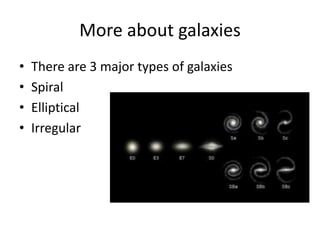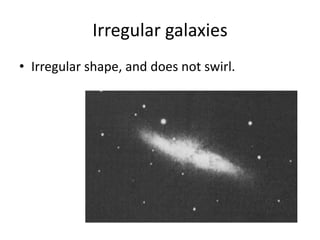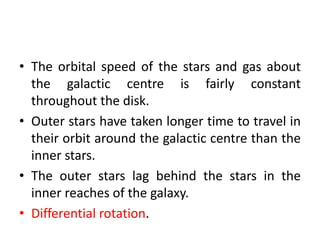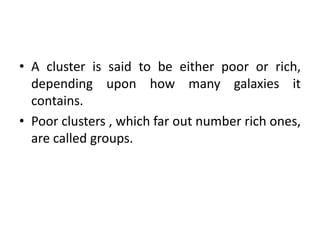Milky way galaxy
- 1. Milky Way Galaxy S.Ganeshan Dept. of Physics Vivekananda College Tiruvedakam West Madurai
- 2. Galaxy •A large assembly of stars and nebulae
- 4. The Milky Way •Our galaxy •Flat disk with spiral arms
- 5. More about galaxies • There are 3 major types of galaxies • Spiral • Elliptical • Irregular
- 6. Spiral galaxies. • Disk shaped with a central bulge. • The center is black Hole
- 7. Elliptical galaxies • Elliptical or round shape • No disk • Stars but no gas
- 8. Irregular galaxies • Irregular shape, and does not swirl.
- 9. Inside the Galaxies • Nebulas (space gas clouds found in spiral galaxies) • Globular Clusters (groups of older stars at the edge of galaxies) • Open Clusters (smaller groups of clusters younger stars)
- 10. Milky Way • Spiral • Contains single stars, double stars, star systems, dust and gases • Shaped like a disk with a bulge in the center – The bulge is very dense
- 11. The Milky Way Galaxy contains dust and gas. Our Solar System is located in Orion’s Arm of the Milky Way Galaxy.
- 13. More Facts about the Milky Way… • Held together by gravity • Can be seen on a very clear night • Got its name from the hazy/milky appearance
- 14. Supernova • A _____________ is basically the death of a large star by explosion.
- 15. An exploding star is known as a supernova.
- 16. Black Holes • A _______ is a giant star or group of stars that has/have collapsed because of their enormous gravity.
- 18. Where did its name come from? •It is called a black hole because not even light can escape!
- 19. • Almost everything we see in the night sky belongs to the Milky Way • From the outside, our Milky Way might look very much like our cosmic neighbor, the Andromeda galaxy
- 23. • It has four major spiral arms and several short arm elements • Each star in the galaxy move in precessing ellipse. • Pin wheel shape of our galaxy suggests that it rotates. • Galaxy does not rotate like a rigid body.
- 24. • The orbital speed of the stars and gas about the galactic centre is fairly constant throughout the disk. • Outer stars have taken longer time to travel in their orbit around the galactic centre than the inner stars. • The outer stars lag behind the stars in the inner reaches of the galaxy. • Differential rotation.
- 25. • Earth goes round the sun once each years, it takes sun 200 million years to go once round the galaxy. • Huge period of time is called galactic year.
- 27. • Galaxies are not uniformly distributed throughout the universe. • Some galaxies seemed to be grouped together in clusters.
- 28. • A cluster is said to be either poor or rich, depending upon how many galaxies it contains. • Poor clusters , which far out number rich ones, are called groups.
- 29. Poor galaxy • Milky Way Galaxy • Andromeda galaxy • Large and small Magellanic clouds • These are called local groups.
- 30. • The local Group contains 30 galaxies
- 31. Thank You






























